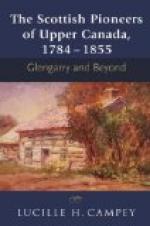Nevertheless, Verrazano’s voyage developed into the French colonization of Canada, just as Cabot drew the British to Newfoundland, Columbus the Spaniards to Central and South America, and Amerigo Vespucci showed the Portuguese the way to Brazil. The modern nations of western Europe owe the inception of their great colonies in America to four Italians.
CHAPTER II
Jacques Cartier
Verrazano and Gomez, and probably the English captain, John Rut, had all sought for the opening of a strait of salt water—like Magellan’s Straits in the far south—which should lead them through the great North-American continent to the regions of China and Japan. Yet in some incomprehensible way they overlooked the two broad passages to the north and south of Newfoundland—the Straits of Belle Isle and of Cabot—which would at any rate lead them into the vast Gulf of St. Lawrence, and thence to the St. Lawrence River and the Great Lakes; a natural system of waterways connected each with the other and all with the Mississippi and Missouri, the Arctic Ocean, and Hudson’s Bay; nay, more, with the North Pacific also; so that with a few “portages”, or carryings of canoes from one watershed to another, a traveller of any enterprise, accompanied by a sturdy crew, can cross the broad continent of North America at its broadest from sea to sea without much walking.
Estevao Gomez noticed Cabot Straits between Cape Breton and Newfoundland, but thought them only a very deep bay. John Rut and others discerned the Straits of Belle Isle as a wide recess in the coast rather than the mouth of a channel leading far inland. And yet, after thirty years of Breton, English, and Portuguese fishing operations in these waters, there must have been glimmerings of the existence of the great Gulf of St. Lawrence behind Newfoundland: and JACQUES CARTIER (or Quartier), who had probably made already one voyage to Newfoundland (besides a visit to Brazil), suspected that between Newfoundland and Labrador there lay the opening of the great sea passage “leading to China”. He proposed himself to Philippe de Chabot, the Admiral of France, as the leader of a new French adventure to find the North-west Passage, was accepted by King Francis, and at the age of forty-three years set out, with two ships, from St. Malo in Brittany, on April 20, 1534,




